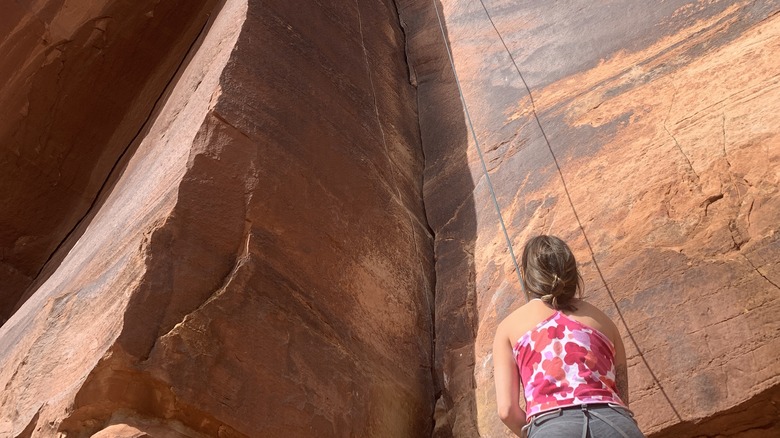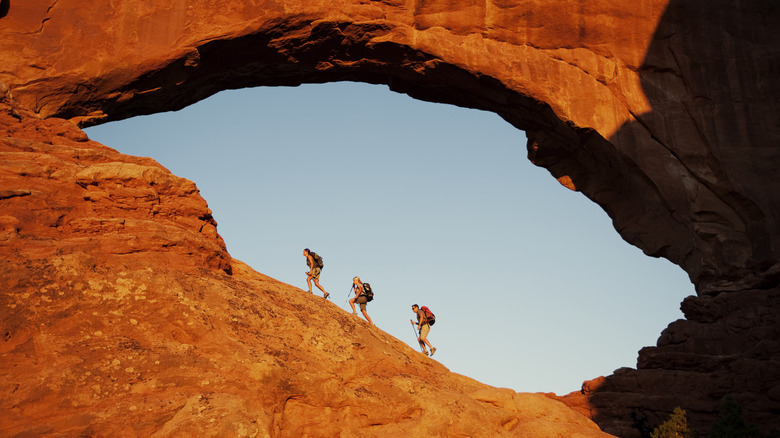Arches National Park Strictly Prohibits One Popular Type Of Rock Climbing Aid
Rock climbers dream about places like Arches National Park in Utah. The 76,000-acre preserve is packed with bare rock faces, including 2,000 of the sandstone arches that give the park its name. If you have overcome any anxiety about heights and honed your skills on smaller cliffs, you may be ready to take on some of Arches' many established routes, which range from beginner-friendly to expert-only. Kick off your Mighty 5 Road Trip in Arches, where the views are epic, fellow climbers are everywhere, and the outdoors capital of Moab is just down the road, waiting for you with a cozy motel room and a pint of IPA.
But before you click into your belay line, there's something you should know. While the traditional tools of climbing — shoes, harnesses, helmets, and ropes — are all permissible in the park, there's one common rock climbing aid that isn't: white chalk. The bleached powder that most climbers slap onto their palms is a no-go in Arches, and anyone caught using white chalk on an ascent will get a stern warning, if not a fine.
The reason is simple: white chalk contrasts sharply with red, the color of most rock faces in Arches. Handprints and smudges are ugly and can be seen a mile away. They also tarnish the purity of these desert vistas in ways that tiny rope anchors do not. In an effort to preserve the natural beauty of the park, rangers require climbers to use only chalk that matches the hue of local geology.
Rock, chalk, and matching colors in Arches National Park
The red surfaces of Arches National Park are world famous. They owe their distinct coloration to iron minerals embedded in the stone; hematite affects rock faces the same way rust affects metal, staining it a similar shade of maroon. Red rock is the pride of the Colorado Plateau, which covers a vast swathe of Southwestern land, including some of the top tourist attractions in the Southwest. Outdoors enthusiasts travel from around the world to see these distinctive rock formations up close, and their reddish complexion is a big part of their appeal.
That said, chalk is extremely handy (no pun intended) for rock climbers, who use it to absorb moisture and improve their grip on sheer surfaces. Chalk is a kind of limestone, made up primarily of calcium carbonate, and in its raw form, nearly all chalk is either pure white or a light gray. Both limestone and sandstone are sedimentary rocks, but their colorations don't mix well.
Luckily, climbing chalk comes in many different colors, including "Mojave Red." A bag of the stuff is generally pretty cheap — about $10 online — so climbers can switch from white to red without breaking the bank. You could order this ahead of time and take it with you to Arches, or you could try to find some in Moab when you arrive, visiting local businesses like Gearheads Outdoor Store or Pagan Mountaineering. Store clerks want to make sure you're following the rules in their cherished national park, including the type of powdered stone you dust your hands with.
Other rules in Arches National Park
The chalk issue is an easy fix, but Arches National Park has a number of other site-specific rules, which would be smart to study before you head out. You can affix new anchors to the mountain face without a permit, and these metal rings should also match the red rock. Most climbers won't have to worry about this; setting anchors is the duty of route-setters, who represent a tiny minority of Arches visitors. Still, you may notice the matching colors as you clip in.
Arches is a curious place to manage, because its iconic landscape is both made out of solid rock and easy to mess up. Limited vegetation means that visitors can see a long way, and you can't hide litter or graffiti on these vast swathes of exposed rock. Chalk-smudges and forgotten beer bottles might disappear in the dense deciduous forests of the East Coast, but they're plain as day on these parchment-like escarpments, and a few unsightly streaks could destroy a photograph of, say, Delicate Arch, the park's most famous landmark.
This caution extends to certain popular sports, as well. Slacklining is prohibited in Arches, despite its popularity elsewhere, as is BASE jumping. This wide-open topography, with its sudden dropoffs and dramatic shifts in elevation, could be perfect for both, but leaping into canyons or balancing on polyester tightropes could distract from the views — and potentially cause damage to the land. Yet some rules can be liberating as well, such as this latest National Park law that travel creators are raving about.


